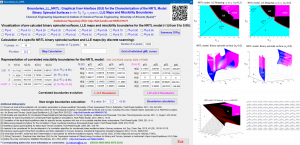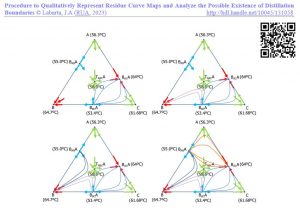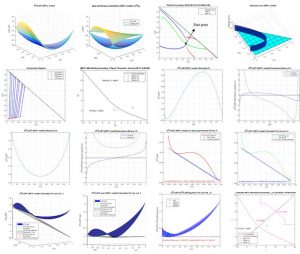Similar to previous MatLab Graphical User Interfaces (GUI’s) developed to systematically check the consistency of LLE data correlation results, GMcal_TieLinesLL (v.2.3), or Boundaries_LL_NRTL for the analysis of the miscibility boundaries that the NRTL model present, this GUI, GMcal_TieLinesVL (new version v.2.3 RUA 2022: http://hdl.handle.net/10045/122857), allows the analysis of experimental and calculated (isobaric or isothermal) vapor-liquid equilibrium data for binary and ternary systems, in the sense presented in the following papers, to detect the necessity of considering larger dependences (of temperature or pressure, respectively) in the binary interaction parameters of the model used (e.g. NRTL model) and also to check the consistency of VLE data correlation results through the topological information contained in the Gibbs energy of mixing function:
This analysis allows researchers involved in the correlation of experimental vapor-liquid equilibrium data, to visualize the experimental data’s behavior and also the consistency and quality of the results obtained in the correlation process.
This new version of the GMcal_TieLinesVL (v.2.3) is also useful to analyze the predictions of the model used (when only the parameters of the corresponding models are known) regarding the possibilities of LLE, analyzing possible critical solution points, in the case of binary systems or the Hessian Matrix, Spinodal Curve and possible Plait Point Location in ternary systems in the corresponding range of experimental (isobaric or isothermal) data, and/or to the existence of distillation boundaries.
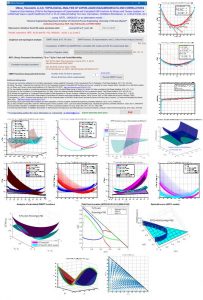
Related references:
Marcilla, A.; Labarta, J.A.; Olaya, M.M. Should we trust all the published LLE correlation parameters in phase equilibria? Necessity of their Assessment Prior to Publication. Fluid Phase Equilibria. 2017, 433, 243-252 (http://dx.doi.org/10.1016/j.fluid.2016.11.009). The 4th most cited article published in Fluid Phase Equilibria in 2017-2020 (extracted from Scopus 11/2020). Research Gate. RUA: http://hdl.handle.net/10045/66521.
Labarta, J.A.; Olaya, M.M.; Marcilla, A. What does the NRTL model look like? Determination of boundaries for different fluid phase equilibrium regions. AIChE Journal. 2022, 68(10), e17805 (https://dx.doi.org/10.1002/aic.17805)
Labarta, J.A.; Olaya, M.M.; Marcilla, A. GMcal_TieLinesLL v.2.2. Graphical User Interface (GUI) for the representation of GM surfaces and curves (for binary and ternary systems), including tie-lines, Hessian Matrix analysis, Critical Point Location, Miscibility Boundaries, etc. Institutional Repository of the University of Alicante (RUA) 2015-2022. (http://hdl.handle.net/10045/51725). (Including a Thermodynamic Review).
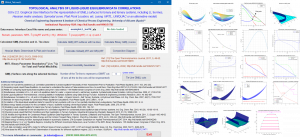
Marcilla, A.; Labarta, J.A.; Serrano M.D.; Olaya, M.M. GE Models and Algorithms for Condensed Phase Equilibrium Data Regression in Ternary Systems: Limitations and Proposals. The Open Thermodynamics Journal. 2011, 5, (Suppl 1-M5) 48-62 (http://dx.doi.org/10.2174/1874396X01105010048).
Labarta, J.A.; Olaya, M.M.; Marcilla, A. Boundaries_LL_NRTL Graphical User Interface (GUI) for the characterization of the NRTL model: Binary Spinodal Surfaces (in the τi,j-τj,i-xi space), LLE maps and Miscibility Boundaries. Institutional Repository of the University of Alicante (RUA) 2022. (http://hdl.handle.net/10045/121471).

Marcilla, A.; Serrano, M.D.; Labarta. J.A.; Olaya, M.M. Checking Liquid-Liquid Critical Plait Conditions and their Application in Ternary Systems. Industrial & Engineering Chemistry Research. 2012, 51(13), 5098-5102. http://dx.doi.org/10.1021/ie202793r.
Olaya, M.M.; Carbonell-Hermida, P.; Trives, M.; Labarta, J.A.; Marcilla, A. LLE data correlation using NRTL model for different types of binary systems: UCST, LCST and closed miscibility loops. Industrial & Engineering Chemistry Research. 2020, 59(17), 8469-8479. https://doi.org/10.1021/acs.iecr.0c00141.
Labarta, J.A.; Serrano, M.D.; Velasco, R.; Olaya, M.M.; Marcilla, A. Approximate Calculation of Distillation Boundaries for Ternary Azeotropic Systems. Ind. Eng. Chem. Res. 2011, 50 (12), 7462-7466. DOI: http://dx.doi.org/10.1021/ie101873.
Labarta, J.A.; Caballero, J.A.; Marcilla, A. Numerical Determination of Distillation Boundaries for Multicomponent Homogeneous and Heterogeneous Azeotropic Systems. Computer Aided Chemical Engineering. 2010, 28(C), 643-648. DOI: http://dx.doi.org/10.1016/S1570-7946(10)28108-7.



